Key takeaways:
- Pro-life advocacy encompasses compassion and emphasizes the interconnectedness of women’s rights, healthcare, and education.
- Storytelling plays a crucial role in bridging gaps in understanding and highlighting the complexities of individual situations in pro-life discussions.
- Effective advocacy strategies include interactive engagement, leveraging social media, and collaborating with other organizations to strengthen outreach efforts.
- Challenges such as misinformation and limited resources require creative solutions and resilience in advocating for pro-life policies.
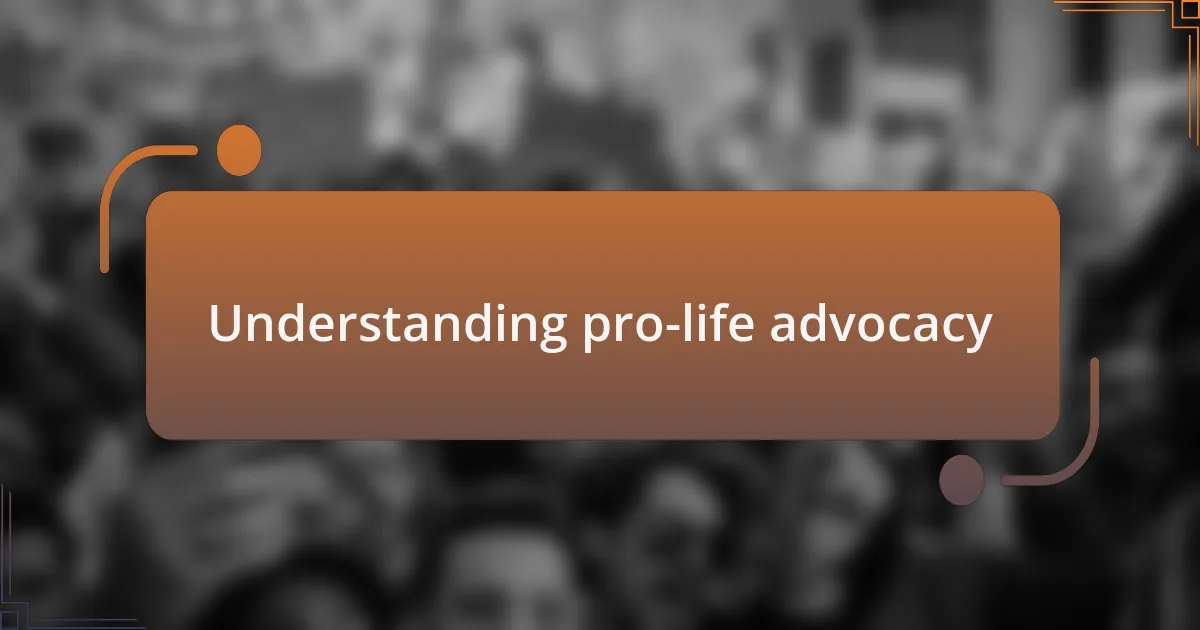
Understanding pro-life advocacy
Pro-life advocacy is often seen through the lens of moral and ethical considerations regarding the sanctity of life. I remember attending a community meeting where someone shared their personal story of choosing life despite overwhelming obstacles. Their testimony left a profound impact on me, sparking questions about the societal pressures faced by individuals in such circumstances.
At its core, pro-life advocacy embodies compassion, urging society to recognize the inherent value of each human being. I often find myself reflecting on the idea that supporting life goes beyond opposing abortion; it also means advocating for comprehensive support systems for mothers and families. Isn’t it essential to think about what happens after birth, too?
Understanding pro-life advocacy means delving into broader discussions about women’s rights, healthcare, and education. I’ve seen firsthand how these interconnected issues shape the decisions people make. When we stand firm in this advocacy, we are not just voicing opposition; we are inviting deeper conversations about love, support, and the potential of every individual life.
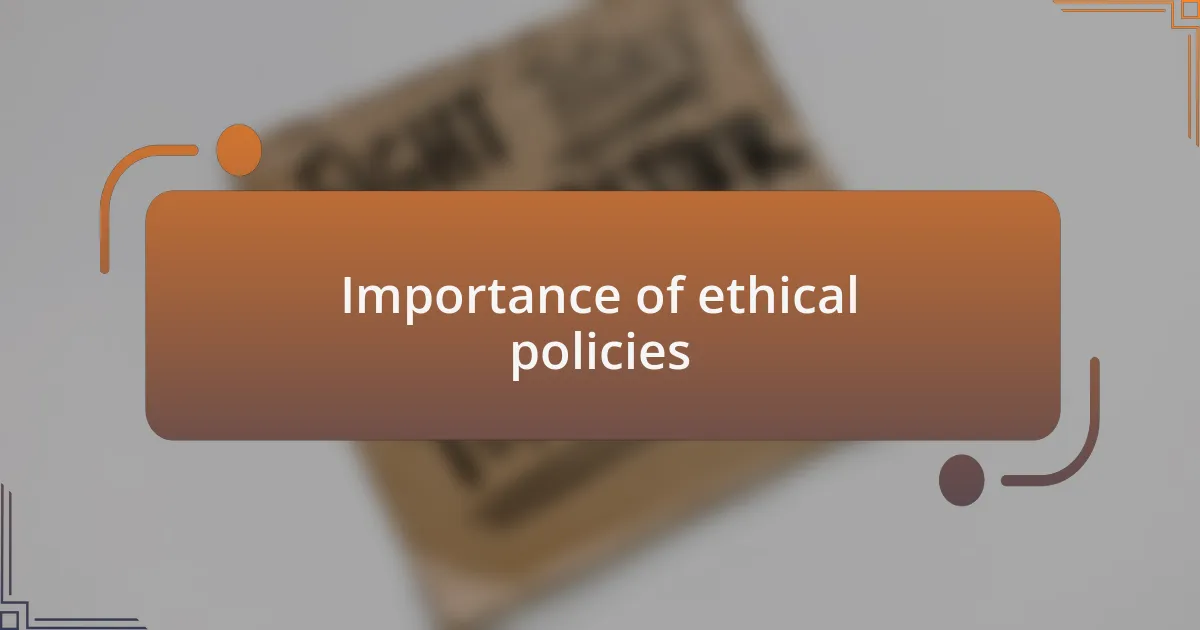
Importance of ethical policies
When it comes to ethical policies, they are vital because they guide the principles we uphold in our advocacy efforts. I remember a time when an ethical dilemma arose in our local group regarding how we should address sensitive topics around pregnancy. Instead of merely jumping into debates, we paused to reflect on what our guiding values were. This moment reinforced my belief that strong ethical policies not only clarify our stance but also ensure we approach discussions with respect and empathy.
Moreover, ethical policies create a foundation for trust within our communities. I vividly recall a workshop where participants shared their experiences of feeling judged for their choices. It became clear that when we establish ethical guidelines, we foster an environment where people feel safe to express their struggles. How can we hope to inspire change if we do not cultivate a culture of understanding and support?
Additionally, these policies are essential in shaping the narrative of our movement. For example, there was an initiative in my community focused on educating teens about the value of life choices. By adhering to ethical standards in messaging and outreach, we not only garnered support but also sparked meaningful conversations among young people. Isn’t it powerful to think that the policies we advocate for can leave a lasting impact on future generations?
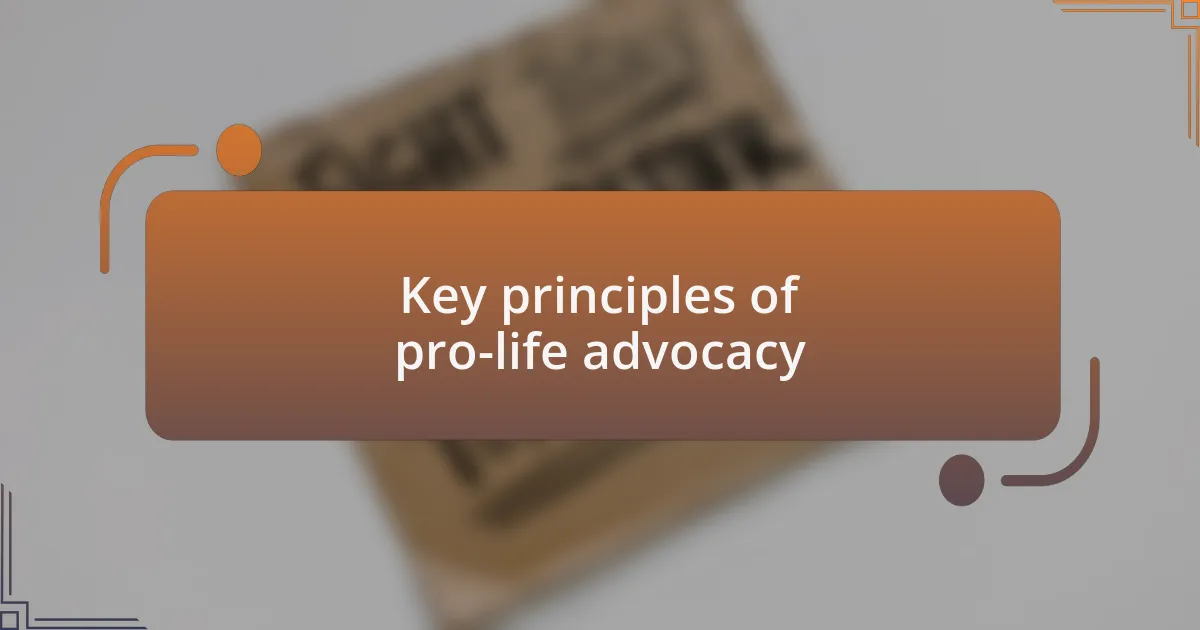
Key principles of pro-life advocacy
Advocating for life is rooted in the belief that every human being has inherent worth. I recall a moment in our discussions when someone shared their story of an unplanned pregnancy. Hearing their fears and hopes reinforced the idea that when we advocate, we must recognize the individual’s dignity and the complexity of their situation. How can we truly stand for life if we don’t first listen and understand the lives we are touching?
Another key principle is the importance of compassion and empathy in our messaging. At a recent community event, I saw firsthand how a compassionate approach can transform conversations. One participant shared a painful experience, and rather than lecture, our group chose to respond with kindness. It made me realize that empathy is a powerful tool in pro-life advocacy. It raises the question: how can we ensure our message resonates if it’s not wrapped in understanding?
Lastly, integrity is a cornerstone of our advocacy efforts. I remember being involved in a campaign that aimed to provide resources for those in crisis. We made it a point to only share factual information and avoid sensationalism. This commitment to honesty not only strengthened our reputation but also built trust in the community. Reflecting on this, I ask myself: how can we expect others to believe in our cause if we don’t uphold transparency?
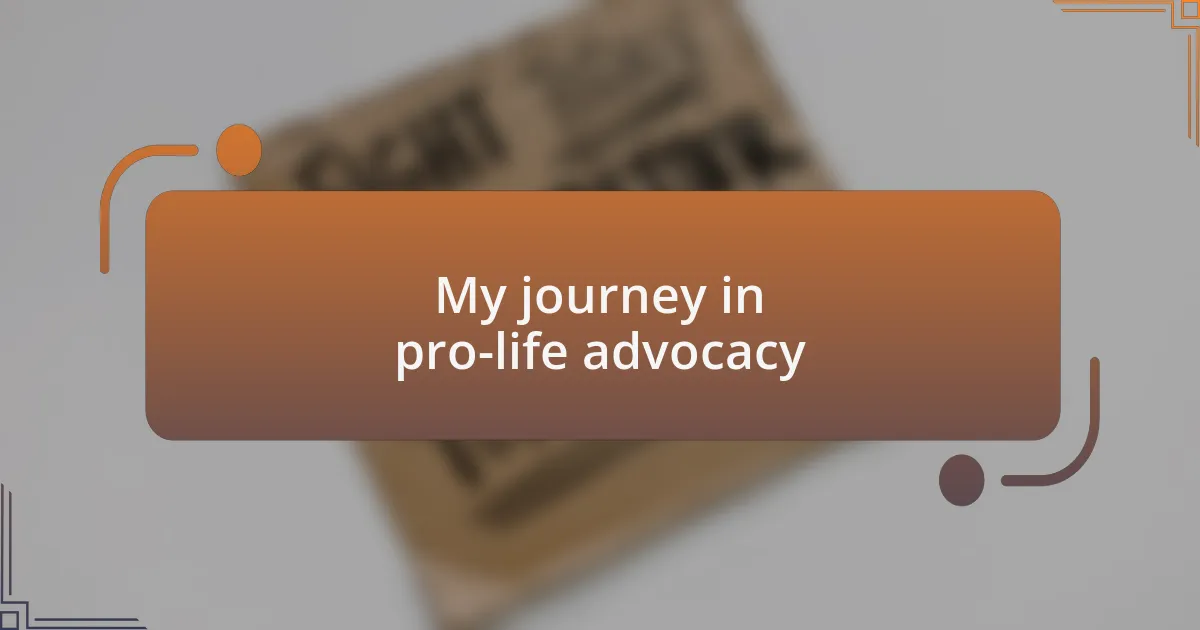
My journey in pro-life advocacy
As I embarked on my journey in pro-life advocacy, I quickly discovered the power of storytelling. One day, I met a woman at a local fair who shared how her decision to carry her child to term completely transformed her life. Hearing her heartfelt narrative not only deepened my commitment but also highlighted the profound impact we can have when we share our experiences. Isn’t it intriguing how personal stories can bridge gaps in understanding?
Another pivotal moment occurred during my participation in a community meeting focused on pro-life initiatives. I vividly remember a young father who spoke about his struggles with the unexpected news of his partner’s pregnancy. His raw emotions revealed to me that pro-life advocacy isn’t just about opposing choices; it’s also about supporting families as they navigate their unique journeys. How can we advocate effectively without acknowledging the real-life challenges people face?
I also encountered resistance, which shaped my perspective further. During a heated debate at a college event, someone challenged my views passionately, and rather than feeling attacked, I found an opportunity for dialogue. Engaging with skeptics not only tested my beliefs but also enriched my understanding of varied perspectives. This experience sparked a question within me: how can we, as advocates, foster dialogue with those who strongly disagree while staying true to our values?
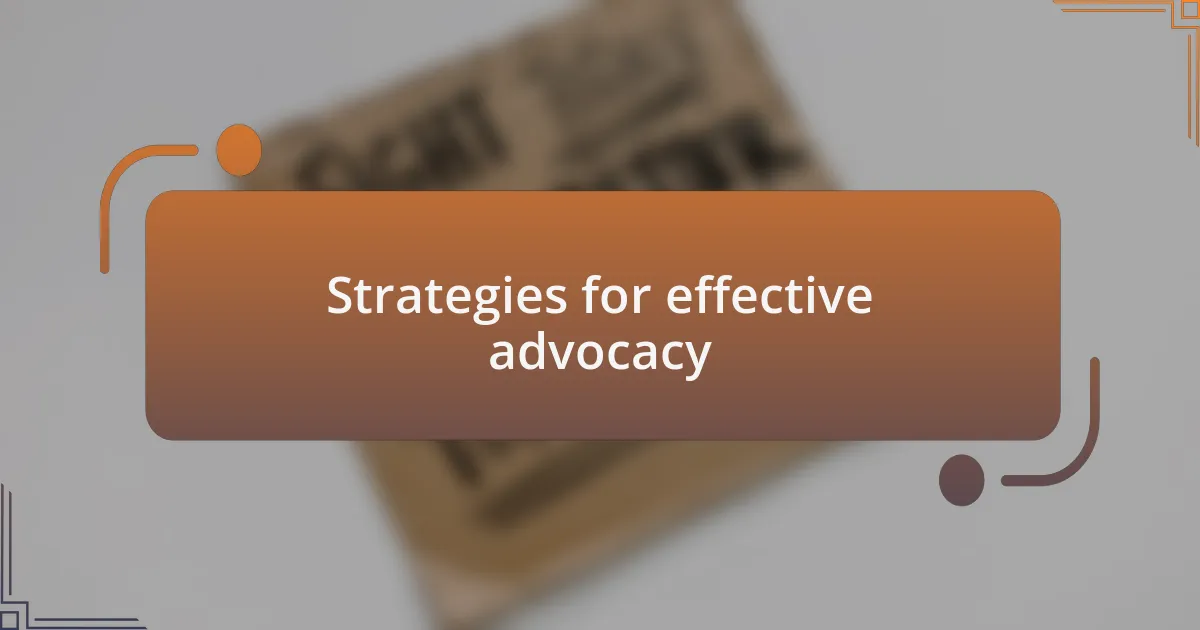
Strategies for effective advocacy
Effective advocacy requires a strategic approach tailored to resonate with diverse audiences. I learned this firsthand during a local outreach event, where I found that incorporating interactive workshops drew more people in. By inviting attendees to participate in discussions rather than merely presenting information, we fostered a sense of community and shared investment in pro-life values. Isn’t it fascinating how engagement can transform a passive audience into active participants?
Another strategy that proved valuable was leveraging social media to amplify our message. I recall a campaign we launched, where personal testimonies shared by individuals in our community reached thousands online. The power of virtual connection allowed us to break down geographical barriers, sparking conversations in corners we never even imagined. Have you ever experienced the ripple effect of a single post or story?
Lastly, collaboration with other organizations helped strengthen our advocacy efforts. I experienced this firsthand while partnering with a local pregnancy resource center. Together, we crafted informative materials that not only promoted our stance but also provided tangible support to those in crisis. This alliance reminded me of the importance of unity in advocacy—how can we make a lasting impact if we don’t join forces with like-minded allies?
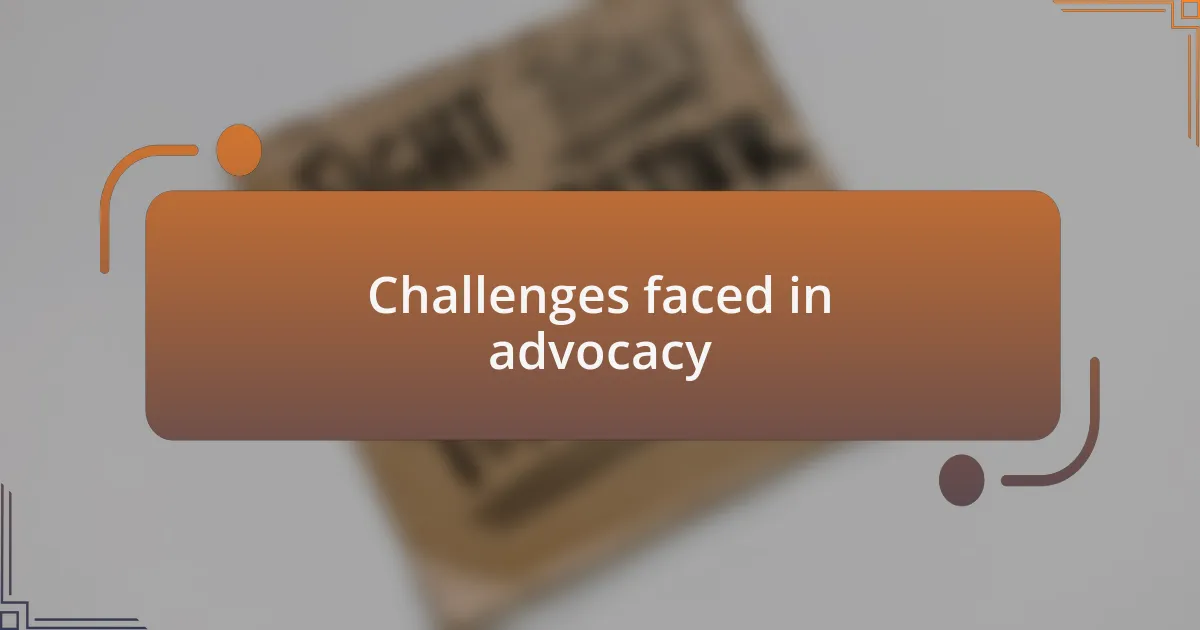
Challenges faced in advocacy
Advocating for pro-life policies often comes with significant challenges, particularly when facing opposition from deeply rooted beliefs. I remember attending a debate where emotions ran high on both sides. It was eye-opening to see how quickly productive dialogue could dissolve into heated arguments. How do you maintain your composure and focus on the goal when faced with such intense pushback?
Another hurdle is the sheer saturation of misinformation that can cloud public perception. During one campaign, I was astounded by the prevalence of false narratives circulating about our movement. It became clear to me that combating misinformation was not just about presenting facts; it also involved empathy and understanding the fears that fuel these misconceptions. Have you ever felt the frustration of trying to correct misunderstandings while still respecting opposing views?
Lastly, limited resources can stifle an advocacy campaign’s reach and effectiveness. I distinctly recall a time when our group struggled with funding for essential materials, which made it difficult to convey our message adequately. This experience taught me the importance of creativity in overcoming obstacles, whether through community fundraising or seeking partnerships. How can we innovate to ensure our voices are heard despite these challenges?

Lessons learned from my experience
There’s a profound lesson in learning how to listen actively. During my time advocating for ethical policies, I had a conversation with someone firmly against my beliefs. Instead of arguing, I simply listened to their story. This experience reinforced my understanding that the heart of advocacy lies not just in presenting your case but in truly hearing others. Have you found that sometimes high emotions can lead to valuable insights?
Another key takeaway has been the importance of building coalitions. On a particular project, I reached out to groups with varying perspectives. By finding common ground and focusing on shared values, we crafted a more robust message that resonated across different audiences. It was a reminder that collaboration can amplify our voices. How often do we consider the power of unity in a cause?
Lastly, I learned the significance of patience and persistence in advocacy. I recall a campaign that didn’t yield immediate results, and there were days when I questioned our approach. But gradually, as we remained steadfast, we started to see shifts in public opinion. This taught me that lasting change often takes time and resilience. Isn’t it fascinating how small efforts can lead to significant progress over time?